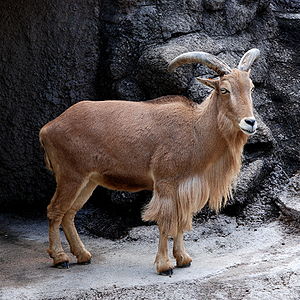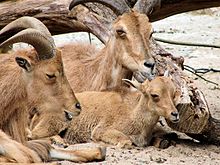Barbary sheep
| Barbary sheep | ||||||||||||
|---|---|---|---|---|---|---|---|---|---|---|---|---|

Barbary sheep ( Ammotragus lervia ) |
||||||||||||
| Systematics | ||||||||||||
|
||||||||||||
| Scientific name of the genus | ||||||||||||
| Ammotragus | ||||||||||||
| Blyth , 1840 | ||||||||||||
| Scientific name of the species | ||||||||||||
| Ammotragus lervia | ||||||||||||
| ( Pallas , 1777) |


The Barbary sheep ( Ammotragus lervia ), also known as Barbary sheep , Barbary sheep or Aoudad known, a northern Africa -based mammalian species of caprine (Caprini).
features
The mane jumper stands between sheep and goats . It reaches a head body length of 1.3 to 1.7 meters, a tail length of 15 to 25 centimeters and a shoulder height of 75 to 110 centimeters. Males weigh 100 to 145 kilograms and are therefore significantly heavier than females, who weigh 40 to 55 kilograms. The fur is beige-brown to reddish-brown in color, the chin, a strip on the belly and the inside of the legs are whitish. The name-giving feature is the long hair on the throat, which extends to the chest and cuffs around the front legs and sometimes reaches down to the floor. In the males, the throat hairs are more pronounced, and the head and body look more massive. Both sexes have horns, but the males grow slightly larger. They curve in a semicircle over the back and can be up to 85 centimeters long.
distribution and habitat
Great barbels live in northern Africa. Their distribution area extends from Morocco and the Western Sahara to Egypt and Sudan . Their habitat are deserts and semi-deserts (such as the Sahara ), where they predominantly inhabit rocky, dry regions.
Lifestyle and diet
Maned jumpers are excellent climbers and, like many desert-dwelling animals, are primarily active at twilight or at night. Since there is no plant privacy screen in their habitat, they remain motionless in case of danger.
They live in small groups. These consist of females with their young who are led by a single buck. He fights for the right to lead the herd against competitors who have to face a duel in which the animals collide with their horns.
Great barbels feed on the grass and leaves of the desert plants. They can do without water for weeks and then only cover their fluid needs with dew and the plant's own juices. However, if they find watering holes, drink plenty of water and even bathe if possible.
Reproduction
Mating can take place all year round, but mostly falls between September and November. After a gestation period of around 160 days, one or often two young animals are born between March and May, rarely triplets. Young animals flee nests and can climb soon after birth. They are weaned after three to four months, and sexual maturity occurs at around 18 months. In human care they can live to be 20 years old.
Mane jumpers and humans
In the Sahara, mane jumpers have always been hunted by the locals (e.g. the Tuareg ) because they are important suppliers of meat, skins, leather and sinews. Due to the changed hunting methods with firearms, the number of stocks has decreased drastically in the last decades, which is why the species is listed as "endangered" ( vulnerable ) by the IUCN . The Egyptian subspecies A. l. ornata , which was already considered extinct, was rediscovered at the end of the 20th century.
Barbary sheep were introduced to California , New Mexico, and Texas in the early 20th century . They have now made their home there and number several thousand animals. Conservationists fear that they will spread further and compete with bighorn sheep native to North America . Also in the Spanish Sierra Espuña ( Murcia ) lives an introduced population of barbary sheep.
Systematics and naming
The close relationship of the barbary sheep is unclear. It can be crossed with a domestic goat , but has both goat and sheep-like characteristics. There is currently a broad consensus among zoologists to assign it to its own genus Ammotragus .
The name Ammotragus comes from the Greek and literally means "sand goat". The term "mane diver" was introduced by Bernhard Grzimek , who considered the previously common name "mane sheep" to be inappropriate; In the meantime, the name has become generally accepted in the German-speaking area, unlike some names that have disappeared again, such as "Mähnenziege" or "Afrikanischer Tur". The name "Aoudad", which is mostly used in the English-speaking world, comes from a Berber language .
literature
- Ronald M. Nowak: Walker's Mammals of the World . Johns Hopkins University Press, 1999 ISBN 0-8018-5789-9
Web links
- Information and distribution map on ultimateungulate.com
- Ammotragus lervia onthe IUCN Red List of Threatened Species . Retrieved July 22, 2009.
- Video: Ammotragus lervia - climbing . Institute for Scientific Film (IWF) 1954, made available by the Technical Information Library (TIB), doi : 10.3203 / IWF / E-14 .
